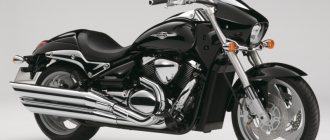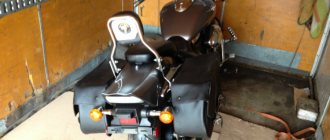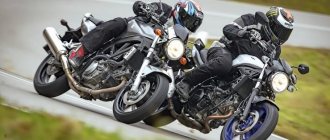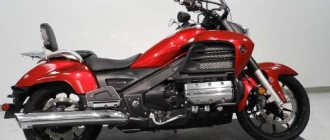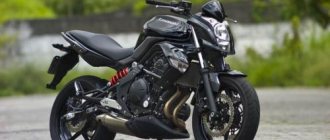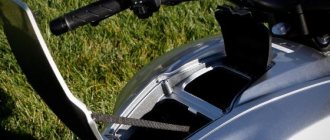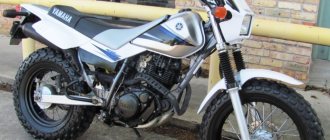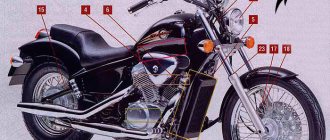GSF 400 Bandit
— a model of a
Suzuki
.
The classic road motorcycle Suzuki GSF 400 Bandit model appeared in 1989 and was initially available only in the Japanese domestic market. Since 1991, the model begins to be officially supplied to Europe and North America. In the vast majority of cases, domestic Japanese modifications are present on the Russian market.
The basis of the Suzuki Bandit 400 was an in-line 4-cylinder liquid-cooled engine with a volume of 398 cm³ and producing 59 hp. power and 38 Nm of torque. Since 1993, due to changes in Japanese legislation, the maximum engine power was reduced to 53 hp. This engine was not independently developed, but migrated from the sports model Suzuki GSX-R400.
In 1991, Suzuki GSF400 Bandit introduced a new modification of the engine with a variable valve control system (VC - variable valve control). Due to the characteristic red color of the cylinder head cover, this modification was called “red-headed”, and the usual modification with a simple engine without this system is called “gray-headed”. Both modifications existed on the market in parallel for almost the entire production period of the model. The “red-headed” modification is also distinguished by red brake discs (inner side) and the presence of the letter “V” in the factory designation. This engine was also installed on a sports tourer - Suzuki RF400.
In 1995, the model underwent a slight restyling, receiving an aluminum swingarm, suspension settings, a new seat and a retuned VC variable valve timing system. This generation is also distinguished by its frame number - GK7AA. The previous generation had a frame with the index - GK75A.
1997 was the last year of production of the Suzuki Bandit 400 model, although official sales of new motorcycles continued until 2000.
Currently, the model is very popular in Russia as one of the cheapest Japanese motorcycles for beginners. The motorcycle is also present in large numbers at Japanese auctions.
Brief history of the model
1989 - start of production and sales. The first generation is GK75A. Model: Suzuki GSF400 Bandit (Japan). Factory designation: GSF400K.
1990 - appearance of a limited version. Model: Suzuki GSF400 Bandit, Suzuki GSF400 Bandit Limited (Japan). Factory designation: GSF400NK, GSF400Z.
1991 - appearance of the “red-headed” modification. Starting this year, models are also exported. Model: Suzuki GSF400 Bandit, Suzuki GSF400 Bandit VC (variable valve control), Suzuki GSF400 Bandit Limited V (Japan, Europe, North America). Factory designation: GSF400M, GSF400VM, GSF400VZM.
1992 - no significant changes. Model: Suzuki GSF400 Bandit; Suzuki GSF400 Bandit VC (variable valve control) (Japan, Europe, North America). Factory designation: GSF400N, GSF400NP; GSF400VP.
1993 - due to changes in Japanese legislation, maximum power is reduced to 53 hp. Model: Suzuki GSF400 Bandit; Suzuki GSF400 Bandit VC (variable valve control) (Japan, Europe, North America). Factory designation: GSF400VR; GSF400VZP.
1994 - model not produced.
1995 - restyling of the model. Second generation - GK7AA. The model receives an update in appearance and chassis. The wheelbase was reduced, the type of footpeg brackets was changed, a new seat and a new aluminum swingarm were obtained. Fuel tank capacity is reduced from 16.0 to 15.0 liters. Model: Suzuki GSF400 Bandit; Suzuki GSF400 Bandit VC (Japan). Factory designation: GSF400S; GSF400VS.
1996 - model not produced.
1997 is the last year of production.
Model: Suzuki GSF400 Bandit VC; Suzuki GSF400 Bandit Limited V (Japan, Europe, North America). Factory designation: GSF400V-V; GSF400VZ-V.
History of motorcycle production
The motorcycle was constantly modified.
Thus, the 1989 models were equipped with clip-ons, there was a rear wing immediately above the wheel, the turn relay was mechanical, and there was no fuel level sensor. For the 1990 model, the clip-ons were replaced with a regular steering wheel. This year's model also had a retuned rear suspension.
In 1991, a separate series of this motorcycle was released - Suzuki Bandit GSF 250 Limited Edition. This version differed from the regular Suzuki Bandit by the presence of a semi-fairing with a headlight fixed on it, attached to the frame.
This one also had a temperature sensor on the dashboard , and the mirror mountings were slightly different. In addition, the location of the carburetors was slightly changed.
In 1992, the Suzuki Bandit was redesigned again. Starting this year, a motor was installed on the bike, the power of which was reduced to 40 hp. But the designers redesigned the gearbox, increasing the gear ratios of 5th and 6th gears.
This motorcycle had clip-ons installed, the turn relay became contactless, and the headlight was constantly on when the engine was running. A Limited Edition version has not yet been released. Also released this year was a model with a standard steering wheel and again a retuned rear shock.
In 1993, a Limited Edition version appeared, already with a 40-horsepower engine. The only difference from the regular version was the existing semi-fairing; otherwise the motorcycles were identical.
In 1995, the second generation of the bike appeared, designated Suzuki Bandit GSF 250-2. The motorcycle was offered with two types of engines: a conventional engine and an engine with variable valve timing.
The second generation models did not have a rear wing above the wheel, and a fuel level sensor appeared. The appearance of the fuel tank, as well as its volume, was changed; the exhaust pipe received a slightly different bend.
Since the second generation, the Limited Edition version has not been produced.
Production of this generation of motorcycles continued until 2000, after which it was decided to end production of the Suzuki Bandit GSF 250 .
But these motorcycles remain popular even now.
Specifications
| Model | Suzuki GSF400 Bandit |
| Motorcycle type | road (street, classic) |
| Year of issue | 1989-1997 |
| Frame | steel tubular |
| engine's type | 4-cylinder, 4-stroke, in-line |
| Working volume | 398 cm³ |
| Bore/Stroke | 56.0 x 40.4 mm |
| Compression ratio | 11.8:1 |
| Cooling | liquid |
| Number of valves per cylinder | DOHC, 4 valves per cylinder GSF400V – VC engine (with variable timing system) |
| Fuel supply system | Carburetor, 4x Mikuni BST33SS Carburetor, 4x Mikuni BST32SS – GSF400 (USA) |
| Ignition type | transistor |
| Maximum power | 59.0 hp (43.4 kW) at 12000 rpm - GSF400 (1989-1992) 53.0 hp (39.0 kW) at 11000 rpm - GSF400 (1993-1997) |
| Maximum torque | 38.0 Nm (3.9 kg*m) at 10500 rpm - GSF400 (1989-1992) 37.0 Nm (3.8 kg*m) at 9500 rpm - GSF400 (1993-1997) |
| Transmission | 6-speed |
| type of drive | chain |
| Front tire size | 110/70R-17M/C 54H |
| Rear tire size | 150/70–17M/C 69H – GK75A 150/60R-17M/C 66H – GK7AA |
| Front brakes | 2 discs, 310 mm, 4-piston calipers 1 disc - GSF400 (North America, Italy) |
| Rear brakes | 1 disc, 260 mm, 2-piston caliper |
| Front suspension | 41 mm telescopic fork (non-adjustable), 120 mm travel – GK75A 41 mm telescopic fork (non-adjustable), 130 mm travel – GK7AA |
| Rear suspension | steel pendulum with monoshock absorber (7-stage preload adjustment), stroke - 120 mm - GK75A aluminum pendulum with monoshock absorber (7-stage preload adjustment), stroke - 128 mm - GK7AA |
| Motorcycle length | 2090 mm – GK75A 2050 mm – GK7AA |
| Motorcycle width | 745 mm – GK75A 730 mm – GK7AA |
| Motorcycle height | 1060 mm – GK75A 1055 mm – GK7AA |
| Wheelbase | 1430 mm – GK75A 1410 mm – GK7AA |
| Seat height | 790 mm – GSF400 (export versions) 745 mm – GSF400 (Japanese versions) |
| Minimum ground clearance (clearance) | 155 mm – GK75A 140 mm – GK7AA |
| Acceleration to 100 km/h | 5.0 sec |
| Maximum speed | 180 km/h |
| Gas tank capacity | 16.0 l – GK75A 15.0 l – GK7AA 14.5 l – GSF400 (California) |
| Motorcycle weight (dry) | 167 kg |
| Motorcycle weight (curb) | 188 kg |
Model overview
The Suzuki Bandit GSF 250 motorcycle was produced for only 11 years , its production ended in 2000, but even now it is the dream of many motorcycle lovers.
The GSF 250 belonged to the classic road motorcycles. And if we take this motorcycle in the modern classification, then it belongs to “naked”, since most motorcycles were not equipped with plastic body kits.
This motorcycle had a tubular frame on which the engine was mounted. The front suspension is made in the form of a telescopic fork. The rear suspension was pendulum with one central shock absorber.
Exhaust gases from each cylinder were discharged into one common exhaust pipe located on the right side of the motorcycle.
The engine design implied the presence of 4 cylinders arranged in a row. This unit had liquid cooling. The cooling radiator was attached to the frame under the tank.
The Suzuki Bandit 250 engine was constantly being redesigned , which affected its technical characteristics. Thus, the engine of the first GSF 250 could produce 45 hp. Later, the power of this engine was reduced to 40 hp.
In order to fully appreciate the Suzuki Bandit 250, you should look at the Kawasaki Ninja 250R, the technical characteristics of which are no less interesting.
It is worth taking a closer look at English-made motorcycles from Triumph. Get acquainted with the model range in our article.
Suzuki GSF 400 Bandit is perhaps the most popular motorcycle among the entire famous “Bandit” line, which includes motorcycles with engines from 250 to 1250 cubic centimeters in volume. This nimble and nimble naked bike is often the first choice of novice motorcyclists, and many, having become familiar with its advantages, ride it for years, not wanting to exchange it for another. Perhaps the Bandit 400 is quite capable of challenging the Honda CB 400 SF for first place in the “most popular motorcycle among beginners” category.
Why is he so popular? Yes, because the GSF 400 boasts excellent driving characteristics, and its handling and braking intensity are much closer to sports motorcycles than to classic ones. At the same time, due to the absence of plastic that breaks on any contact with asphalt, the Suzuki Bandit 400 is very durable in urban conditions. There are several versions of this motorcycle. The first was produced from 1989 to 1994, the second - from 1994 to 1999, and among both generations there were modifications of the GSF 400V, which differed in the gas distribution mechanism. However, there are no subjective differences between these models.
The advantages of the Suzuki Bandit 400 include a truly spirited engine, powerful four-piston front brakes, a rigid chassis and a progressive rear suspension.
The main feature of the GSF 400 is its inline 4-cylinder liquid-cooled engine mounted in a tubular steel frame. The dynamic engine powering the new Suzuki Bandit 250 and Bandit 400 is derived from the GSX-R250 and GSX-R400 respectively and boasts sporting roots. The braking system of the motorcycle is also excellent. Dual disc brakes on the front wheel, borrowed from the aforementioned 400cc jixer, stop the GSF 400 quickly and efficiently, and the rigidity and strength are more than well matched to the power and speed characteristics of the motorcycle. By the way, it is worth paying attention to the presence of a mudguard on the rear swingarm, especially if you choose a used Suzuki Bandit 400, since without it the rear shock absorber can quickly become unusable.
The GSF 400 has very few disadvantages, and these include, perhaps, a slightly too soft fork, which, however, can be treated by installing other springs, as well as the requirement for professional maintenance. Since the Suzuki Bandit 400 is a motorcycle that loves high speeds, and is also very dynamic, it needs good tires. Well, of course, you shouldn’t skimp on motor oil. The most significant drawback is that if you are over 180 cm tall, it is difficult to fit comfortably on this motorcycle. For example, the legs of a tall person do not fit into the stampings on the gas tank at all, and no tuning steps will help here, because the entire geometry of the driver’s seat is designed for people no taller than average.
Be that as it may, the Suzuki Bandit 400 is one of the best in its class. “Evil” in a sporty way, it has a comfortable classic seating position, a smooth gearbox and excellent brakes. It is not surprising that it is so often chosen by beginners, and not only them. However, the Suzuki Bandit 750 and Bandit 1200 are no less popular, but due to their characteristics, they are usually preferred by more experienced motorcyclists.
Similar articles:
- Review of Suzuki GSF 1250 Bandit
- Review of Suzuki GSF 1200 Bandit
- Review of Suzuki GSF 250 Bandit
- Review of Suzuki GSF 600 Bandit
- Review of Suzuki GSF 650 Bandit
- Popular 400cc classics: CB 400, Bandit 400, XJR 400
LiveJournal
Suzuki GSF 600 Bandit - Brief Review
Suzuki GSF 600 Bandit / Suzuki GSF 600 Bandit
The legendary Suzuki Bandit was replenished with a 600 cc version in 1995. Constant updates and improvements have brought these motorcycles to a leading position. Suzuki GSF 600 Bandit is ideal for city traffic. Its maneuverability and controllability know no bounds, and its comfortable seating position and surprisingly soft suspension will provide a decent level of comfort on roads with poor quality surfaces.
The 600 cc engine is the “golden mean” in the Bandits’ engine range. This motor is both strong and soft, so the GSF 600 modification is perfect for beginners, but on the condition that the biker is already familiar with motorcycles. The power plant is fed by Keihin carburetors with sensor-based damper position sensors, which optimizes the flow of performance and evens out traction.
Traditional disc brakes perform their duties adequately. The comfort of use of the Suzuki GSF 600 Bandit is determined by energy-intensive suspensions and a comfortable seating position. For those who like fast and long highway trips, there is the “S” version with a carefully designed aerodynamic fairing and good wind protection. The bold appearance, maneuverability and power of the 600 cc engine ensured the Suzuki Bandit leadership in the urban “streetfighter” segment.
Story
The first model was born in 1989. A year later, a luxury variety was created. It did not have significant differences from the original, but was equipped with plastic fairings and a stiffer suspension. In mid-1991, a modified model was released.
It had a V-shaped engine with modified gas distribution phases. This specimen had the property of sharp acceleration that occurred after 8000 rpm. This feature made the vehicle in question popular not only among young motorcyclists, but also professional bikers.
The production of this model officially ceased in 1997, when the company switched to the production of vehicles with a volume of more than 600 cubic meters. It became popular not only in Japan, but also in Europe and America. Since 1993, an electronic maximum speed limiter of up to 180 km/h began to be installed on the engine. A similar device also reduced power to 53 hp. This figure decreased by 10%.
At the same time, they tried to make the operational process more convenient and added a small luggage compartment under the seat. In 1995, the motorcycle frame became what fans are used to seeing today. After this, no significant modifications or improvements were made.
Designers tried to improve the appearance by installing plastic fairings, changing the shape of the exhaust pipes and muffler. Attempts have been made to use a variety of alloys to produce the swingarm and frame. Both chrome-plated steel and aluminum were used as the basis. The engine underwent some modifications. At the same time, there was no talk of removing the maximum power and speed limits.
The motorcycle, produced in 1995, included more modern solutions and had certain features that made it better than the previous model. These include:
- Solid seat for both driver and passenger.
- The total weight of the vehicle decreased by 5 kg.
- The design included a pendulum made of aluminum alloy.
- The rims are painted black.
- The footrests have become more comfortable.
However, even today this beautiful motorcycle can be found on the roads and all its positive aspects can be appreciated. Suzuki GSF 400 Bandit is owned by experienced motorcyclists who keep it in working order. They are attracted by its aggressive nature and some operational features that make the vehicle in question unique.
Previous entry Suzuki bandit 250 (suzuki bandit 250) - technical characteristics Next entry Features and advantages of the Taiga snowmobile
